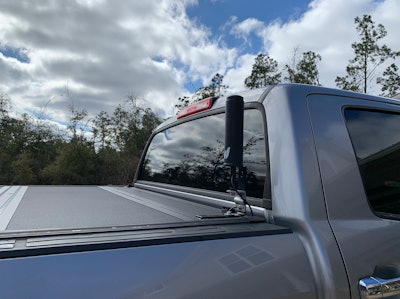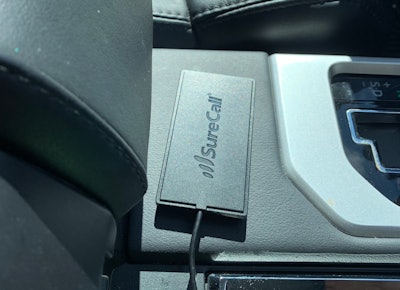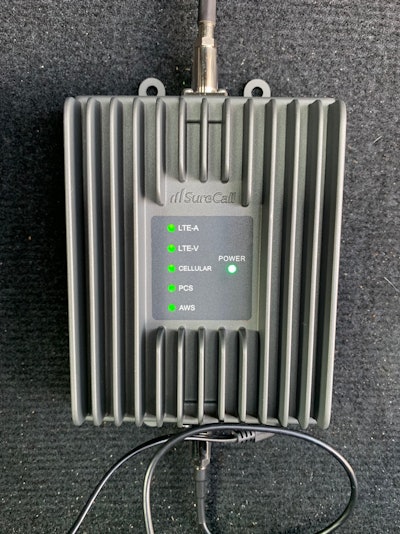Driving can be challenging enough. Driving with a weak cell phone signal is even worse.
With all the functions a cell phone provides like voice calls, texting, traffic alerts, fleet telematics, mobile hot spotting and more, missing out on a reliable signal isn’t much of an option.
 SureCall’s Fusion2Go OTR cell phone signal booster is advertised as their “most powerful vehicle cell phone signal booster…for semi-trucks, work vans, commercial fleets, trailers, off-road vehicles and RVs.” CCJ senior editor Tom Quimby mounted the 9-inch tall antenna onto his hardtop tonneau.Commercial Carrier Journal
SureCall’s Fusion2Go OTR cell phone signal booster is advertised as their “most powerful vehicle cell phone signal booster…for semi-trucks, work vans, commercial fleets, trailers, off-road vehicles and RVs.” CCJ senior editor Tom Quimby mounted the 9-inch tall antenna onto his hardtop tonneau.Commercial Carrier Journal
SureCall promotes easy installation and it certainly can be given the right conditions. In this case, the Fusion2Go OTR kit includes an antenna mount that easily clamps onto the steel support bar of a truck’s side mirror.
But that’s it. If your truck’s mirror is supported by one large arm, as is the case with newer model trucks from icons like Freightliner and Kenworth, then you’re going to have to come up with another mount. For that matter, that’s also the case for other trucks, including pickups, that do not have a side mirror support bar.
For my 2014 Toyota Tundra, I made a no-drill antenna mount behind the cab that was compatible with my hard tonneau. It turned out fine but it did take some planning and a few trips to the hardware store to pull it off.
Though taller is better when it comes to signal reception, I didn’t want to mount the antenna above the cab where it would be buffeted by wind while traveling down the road and stress the mount. Thankfully, SureCall offers 16- and 32-inch antenna height options. I went with the 16-inch option and dropped it down another 3 ½ inches by omitting the spring. I could always add the extra height if needed which hasn’t been the case so far.
If you’re going to mount the SureCall antenna through something that’s not grounded to the chassis, which is the case for my tonneau, just be sure to run a separate ground wire from the antenna mount to the chassis and test it for continuity to ensure a solid connection.
 SureCall’s patch antenna which is mounted inside the vehicle comes with a hook and loop fastener. The 12-foot long cable allows for placement just about anywhere inside the truck. The closer to the phone, the better for signal improvement.Commercial Carrier Journal
SureCall’s patch antenna which is mounted inside the vehicle comes with a hook and loop fastener. The 12-foot long cable allows for placement just about anywhere inside the truck. The closer to the phone, the better for signal improvement.Commercial Carrier Journal
After mounting the antenna, I ran the antenna’s coax under the truck and secured it along the frame rail before running it through a rubber grommet on the floor about 10 inches in front of the right front seat. The small diameter of the cable (comparable to CB coax RG58) allows for an unnoticeable run under the carpet to beneath the right front seat.
In addition to the 10-foot long cable that comes attached to the antenna, SureCall includes a 5-foot extension for longer runs. I had to use both cables given a lengthy run from the bed to the front of the cab. The kit also includes additional coax connectors for additional configurations.
The amplifier only measures 4×5-x1 inches, which makes it fairly easy to conceal. After attaching the external antenna, I installed the amp under the right front seat. Another cable for a smaller antenna inside the cab (or multi-device patch antenna as SureCall calls it) attaches to the other side of the amplifier. The cable’s 10-foot length and the antenna’s small profile allows for installation nearly anywhere in the cab. Just keep in mind that the closer the patch antenna is to a phone, the better. Given that, I chose not to use the Velcro mount so that the antenna can be freely moved around inside the cab if necessary.
An easy power connection to the amp comes courtesy of a 12-foot long power cable, which simply plugs into a cigarette lighter outlet. A switch on the plug makes it easy to turn the amp on and off.
Signal boost
Cell phone boosters are required to be registered with your carrier prior to use. Some carriers, including Verizon, offer an online form that’s fairly easy to fill out. Others may require a phone call with a representative to verify compatibility. SureCall is advertised to work with all carriers and all devices.
 The SureCall amp’s small size at 4- x 5- x 1-inches provides some flexibility for mounting. This one fit nicely under the passenger seat.Commercial Carrier Journal
The SureCall amp’s small size at 4- x 5- x 1-inches provides some flexibility for mounting. This one fit nicely under the passenger seat.Commercial Carrier Journal
Excited about my newfound power, I ran inside and recruited another phone user in our family to give it a try. Same results. Both phones held steady at three bars when held about three feet away from the inside antenna and went up to four when placed on the patch. Not bad!
To get a better idea of signal quality, I activated my iPhone’s in-field service app by dialing *3001#12345*. Just know that once you dial that number, you may get different options depending on your carrier. With StraightTalk, a page pops up titled All Metrics. From there, I choose Serving Cell Info under the header RAT (Radio Access Technology). A long list of metrics pops up that mean absolutely nothing to me save for RSRP (Reference Signal Receive Power). RSRP indicates signal strength with negative numbers that, according to longtime wireless experts at Digi International, typically range from a good strength of -44dBm (decibel-milliwatts) to a horrendous -140dBm. In the case of the latter, you may be better off with two Dixie cups and a string.
Without SureCall, our cell phones at the house usually range between -100 and -123dBm.
Not so good. With the booster on, our best rating was -58dBm, a noticeable improvement.
As everyone knows, while out driving cell phone strength can get noticeably better and worse. It’s a constant see-saw leaving most people familiar with areas that offer great coverage and those that don’t.
Here in Northwest Florida, we still have dead zones though not nearly as bad as they once were. After driving around for about 75 miles, we consistently saw signal boosts of one and two bars in some areas that offered one or, in the case of State 20 just west of Bruce, nothing at all.
The best RSRP boost was an impressive 45dBM. Our best RSRP value remained at -58dBm. Keep in mind that we’re not running the taller 32-inch antenna extension which could mean even better gains. However, there’s no need for me to run the taller mast at this point.
Since I use my phone’s mobile hotspot frequently to access the web while on the road, I gave my laptop a performance check using the booster. Playing high resolution video is usually a good indicator. In this case, I had no hiccups. Everything came through crystal clear.
SureCall suggests making a phone call in an area where you’ve typically run into signal problems. With the booster on, we didn’t run into any phone or streaming issues in areas where we’ve frequently had connectivity problems.
SureCall offers support through its website, a toll-free number and an email address. Using the toll-free number, I got through right away to a helpful agent who submitted my question to tech support Monday morning regarding the availability of other antenna mounts. I’ll keep you posted. In the meantime, I’m enjoying a more reliable signal among the trees.
